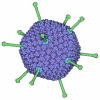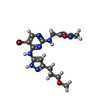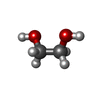[English] 日本語
 Yorodumi
Yorodumi- PDB-4f64: Crystal structure of Human Fibroblast Growth Factor Receptor 1 Ki... -
+ Open data
Open data
- Basic information
Basic information
| Entry | Database: PDB / ID: 4f64 | ||||||
|---|---|---|---|---|---|---|---|
| Title | Crystal structure of Human Fibroblast Growth Factor Receptor 1 Kinase domain in complex with compound 6 | ||||||
 Components Components | Fibroblast growth factor receptor 1 | ||||||
 Keywords Keywords | TRANSFERASE/TRANSFERASE INHIBITOR / kinase / ATP binding / phosphorylation / trans-membrane / TRANSFERASE-TRANSFERASE INHIBITOR complex | ||||||
| Function / homology |  Function and homology information Function and homology informationSignaling by FGFR1 amplification mutants / negative regulation of fibroblast growth factor production / positive regulation of mitotic cell cycle DNA replication / regulation of extrinsic apoptotic signaling pathway in absence of ligand / Signaling by plasma membrane FGFR1 fusions / diphosphate metabolic process / regulation of phosphate transport / FGFR1c and Klotho ligand binding and activation / regulation of lateral mesodermal cell fate specification / positive regulation of MAPKKK cascade by fibroblast growth factor receptor signaling pathway ...Signaling by FGFR1 amplification mutants / negative regulation of fibroblast growth factor production / positive regulation of mitotic cell cycle DNA replication / regulation of extrinsic apoptotic signaling pathway in absence of ligand / Signaling by plasma membrane FGFR1 fusions / diphosphate metabolic process / regulation of phosphate transport / FGFR1c and Klotho ligand binding and activation / regulation of lateral mesodermal cell fate specification / positive regulation of MAPKKK cascade by fibroblast growth factor receptor signaling pathway / cementum mineralization / vitamin D3 metabolic process / regulation of branching involved in salivary gland morphogenesis by mesenchymal-epithelial signaling / response to sodium phosphate / fibroblast growth factor receptor signaling pathway involved in orbitofrontal cortex development / ventricular zone neuroblast division / receptor-receptor interaction / Epithelial-Mesenchymal Transition (EMT) during gastrulation / positive regulation of phospholipase activity / chordate embryonic development / auditory receptor cell development / positive regulation of parathyroid hormone secretion / mesenchymal cell proliferation / paraxial mesoderm development / FGFR1b ligand binding and activation / regulation of postsynaptic density assembly / Signaling by activated point mutants of FGFR1 / fibroblast growth factor receptor activity / FGFR1c ligand binding and activation / organ induction / Downstream signaling of activated FGFR1 / branching involved in salivary gland morphogenesis / Phospholipase C-mediated cascade: FGFR1 / lung-associated mesenchyme development / cell projection assembly / outer ear morphogenesis / embryonic limb morphogenesis / positive regulation of endothelial cell chemotaxis / positive regulation of vascular endothelial cell proliferation / positive regulation of mesenchymal cell proliferation / ureteric bud development / middle ear morphogenesis / skeletal system morphogenesis / inner ear morphogenesis / phosphatidylinositol-mediated signaling / PI-3K cascade:FGFR1 / Formation of paraxial mesoderm / positive regulation of stem cell proliferation / midbrain development / fibroblast growth factor binding / positive regulation of MAP kinase activity / regulation of cell differentiation / PI3K Cascade / epithelial to mesenchymal transition / fibroblast growth factor receptor signaling pathway / positive regulation of blood vessel endothelial cell migration / chondrocyte differentiation / cardiac muscle cell proliferation / calcium ion homeostasis / SHC-mediated cascade:FGFR1 / positive regulation of cardiac muscle cell proliferation / cell maturation / cellular response to fibroblast growth factor stimulus / FRS-mediated FGFR1 signaling / positive regulation of neuron differentiation / Signaling by FGFR1 in disease / NCAM signaling for neurite out-growth / SH2 domain binding / peptidyl-tyrosine phosphorylation / stem cell proliferation / Signal transduction by L1 / skeletal system development / stem cell differentiation / positive regulation of cell differentiation / Negative regulation of FGFR1 signaling / sensory perception of sound / positive regulation of neuron projection development / receptor protein-tyrosine kinase / neuron migration / neuron projection development / Constitutive Signaling by Aberrant PI3K in Cancer / cell migration / PIP3 activates AKT signaling / MAPK cascade / heparin binding / protein autophosphorylation / PI5P, PP2A and IER3 Regulate PI3K/AKT Signaling / RAF/MAP kinase cascade / cytoplasmic vesicle / protein tyrosine kinase activity / angiogenesis / gene expression / in utero embryonic development / protein phosphorylation / positive regulation of phosphatidylinositol 3-kinase/protein kinase B signal transduction / receptor complex / postsynapse / positive regulation of MAPK cascade / positive regulation of cell population proliferation / glutamatergic synapse Similarity search - Function | ||||||
| Biological species |  Homo sapiens (human) Homo sapiens (human) | ||||||
| Method |  X-RAY DIFFRACTION / X-RAY DIFFRACTION /  MOLECULAR REPLACEMENT / Resolution: 2.05 Å MOLECULAR REPLACEMENT / Resolution: 2.05 Å | ||||||
 Authors Authors | Norman, R.A. / Breed, J. / Ogg, D. | ||||||
 Citation Citation |  Journal: J.Med.Chem. / Year: 2012 Journal: J.Med.Chem. / Year: 2012Title: Protein-Ligand Crystal Structures Can Guide the Design of Selective Inhibitors of the FGFR Tyrosine Kinase. Authors: Norman, R.A. / Schott, A.K. / Andrews, D.M. / Breed, J. / Foote, K.M. / Garner, A.P. / Ogg, D. / Orme, J.P. / Pink, J.H. / Roberts, K. / Rudge, D.A. / Thomas, A.P. / Leach, A.G. | ||||||
| History |
|
- Structure visualization
Structure visualization
| Structure viewer | Molecule:  Molmil Molmil Jmol/JSmol Jmol/JSmol |
|---|
- Downloads & links
Downloads & links
- Download
Download
| PDBx/mmCIF format |  4f64.cif.gz 4f64.cif.gz | 228.1 KB | Display |  PDBx/mmCIF format PDBx/mmCIF format |
|---|---|---|---|---|
| PDB format |  pdb4f64.ent.gz pdb4f64.ent.gz | 181.6 KB | Display |  PDB format PDB format |
| PDBx/mmJSON format |  4f64.json.gz 4f64.json.gz | Tree view |  PDBx/mmJSON format PDBx/mmJSON format | |
| Others |  Other downloads Other downloads |
-Validation report
| Summary document |  4f64_validation.pdf.gz 4f64_validation.pdf.gz | 1 MB | Display |  wwPDB validaton report wwPDB validaton report |
|---|---|---|---|---|
| Full document |  4f64_full_validation.pdf.gz 4f64_full_validation.pdf.gz | 1 MB | Display | |
| Data in XML |  4f64_validation.xml.gz 4f64_validation.xml.gz | 28.1 KB | Display | |
| Data in CIF |  4f64_validation.cif.gz 4f64_validation.cif.gz | 37 KB | Display | |
| Arichive directory |  https://data.pdbj.org/pub/pdb/validation_reports/f6/4f64 https://data.pdbj.org/pub/pdb/validation_reports/f6/4f64 ftp://data.pdbj.org/pub/pdb/validation_reports/f6/4f64 ftp://data.pdbj.org/pub/pdb/validation_reports/f6/4f64 | HTTPS FTP |
-Related structure data
| Related structure data |  4f63C  4f65C  1fgkS C: citing same article ( S: Starting model for refinement |
|---|---|
| Similar structure data |
- Links
Links
- Assembly
Assembly
| Deposited unit | 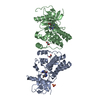
| ||||||||
|---|---|---|---|---|---|---|---|---|---|
| 1 |
| ||||||||
| Unit cell |
|
- Components
Components
| #1: Protein | Mass: 35135.340 Da / Num. of mol.: 2 / Fragment: kinase domain (UNP residues 458-765) / Mutation: C488A, C584S Source method: isolated from a genetically manipulated source Source: (gene. exp.)  Homo sapiens (human) / Gene: FGFR1, BFGFR, CEK, FGFBR, FLG, FLT2, HBGFR / Production host: Homo sapiens (human) / Gene: FGFR1, BFGFR, CEK, FGFBR, FLG, FLT2, HBGFR / Production host:  References: UniProt: P11362, receptor protein-tyrosine kinase #2: Chemical | #3: Chemical | ChemComp-EDO / #4: Chemical | ChemComp-SO4 / | #5: Water | ChemComp-HOH / | |
|---|
-Experimental details
-Experiment
| Experiment | Method:  X-RAY DIFFRACTION / Number of used crystals: 1 X-RAY DIFFRACTION / Number of used crystals: 1 |
|---|
- Sample preparation
Sample preparation
| Crystal | Density Matthews: 2.65 Å3/Da / Density % sol: 53.66 % |
|---|---|
| Crystal grow | Temperature: 277 K / Method: vapor diffusion, hanging drop Details: 16-20% PEG8000, 100 mM PCTP, 100-300 mM ammonium sulfate, 25% ethylene glycol, pH 6.25-7.25, VAPOR DIFFUSION, HANGING DROP, temperature 277K PH range: 6.25-7.25 |
-Data collection
| Diffraction | Mean temperature: 110 K |
|---|---|
| Diffraction source | Source:  ROTATING ANODE / Type: RIGAKU MICROMAX-007 / Wavelength: 1.54 Å ROTATING ANODE / Type: RIGAKU MICROMAX-007 / Wavelength: 1.54 Å |
| Detector | Type: RIGAKU SATURN 92 / Detector: CCD / Date: Dec 23, 2004 |
| Radiation | Protocol: SINGLE WAVELENGTH / Monochromatic (M) / Laue (L): M / Scattering type: x-ray |
| Radiation wavelength | Wavelength: 1.54 Å / Relative weight: 1 |
| Reflection | Resolution: 2.05→61.931 Å / Num. all: 46555 / Num. obs: 44839 / % possible obs: 96.75 % / Observed criterion σ(F): 1 / Observed criterion σ(I): 1 / Redundancy: 2.7 % / Rmerge(I) obs: 0.149 / Rsym value: 0.128 / Net I/σ(I): 6.6 |
| Reflection shell | Resolution: 2.05→2.16 Å / Redundancy: 2.7 % / Rmerge(I) obs: 0.572 / Mean I/σ(I) obs: 2.2 / Rsym value: 0.504 / % possible all: 96.06 |
- Processing
Processing
| Software |
| |||||||||||||||||||||||||||||||||||||||||||||||||||||||||||||||||||||||||||||||||||||||||||||||||||||||||||||||||||||||||||||
|---|---|---|---|---|---|---|---|---|---|---|---|---|---|---|---|---|---|---|---|---|---|---|---|---|---|---|---|---|---|---|---|---|---|---|---|---|---|---|---|---|---|---|---|---|---|---|---|---|---|---|---|---|---|---|---|---|---|---|---|---|---|---|---|---|---|---|---|---|---|---|---|---|---|---|---|---|---|---|---|---|---|---|---|---|---|---|---|---|---|---|---|---|---|---|---|---|---|---|---|---|---|---|---|---|---|---|---|---|---|---|---|---|---|---|---|---|---|---|---|---|---|---|---|---|---|---|
| Refinement | Method to determine structure:  MOLECULAR REPLACEMENT MOLECULAR REPLACEMENTStarting model: PDB ENTRY 1FGK Resolution: 2.05→61.9 Å / Cor.coef. Fo:Fc: 0.933 / Cor.coef. Fo:Fc free: 0.885 / SU B: 13.472 / SU ML: 0.157 / Cross valid method: THROUGHOUT / ESU R: 0.198 / ESU R Free: 0.187 / Stereochemistry target values: MAXIMUM LIKELIHOOD / Details: HYDROGENS HAVE BEEN ADDED IN THE RIDING POSITIONS
| |||||||||||||||||||||||||||||||||||||||||||||||||||||||||||||||||||||||||||||||||||||||||||||||||||||||||||||||||||||||||||||
| Solvent computation | Ion probe radii: 0.8 Å / Shrinkage radii: 0.8 Å / VDW probe radii: 1.2 Å / Solvent model: BABINET MODEL WITH MASK | |||||||||||||||||||||||||||||||||||||||||||||||||||||||||||||||||||||||||||||||||||||||||||||||||||||||||||||||||||||||||||||
| Displacement parameters | Biso mean: 26.505 Å2
| |||||||||||||||||||||||||||||||||||||||||||||||||||||||||||||||||||||||||||||||||||||||||||||||||||||||||||||||||||||||||||||
| Refinement step | Cycle: LAST / Resolution: 2.05→61.9 Å
| |||||||||||||||||||||||||||||||||||||||||||||||||||||||||||||||||||||||||||||||||||||||||||||||||||||||||||||||||||||||||||||
| Refine LS restraints |
| |||||||||||||||||||||||||||||||||||||||||||||||||||||||||||||||||||||||||||||||||||||||||||||||||||||||||||||||||||||||||||||
| LS refinement shell | Resolution: 2.05→2.103 Å / Total num. of bins used: 20
| |||||||||||||||||||||||||||||||||||||||||||||||||||||||||||||||||||||||||||||||||||||||||||||||||||||||||||||||||||||||||||||
| Refinement TLS params. | Method: refined / Origin x: 58.2529 Å / Origin y: -0.0891 Å / Origin z: 16.3069 Å
| |||||||||||||||||||||||||||||||||||||||||||||||||||||||||||||||||||||||||||||||||||||||||||||||||||||||||||||||||||||||||||||
| Refinement TLS group |
|
 Movie
Movie Controller
Controller





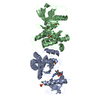
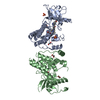
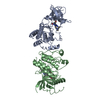
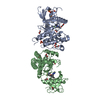
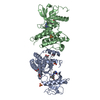
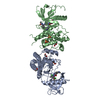
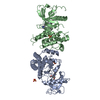

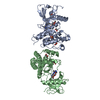

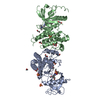


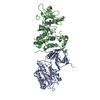
 PDBj
PDBj




